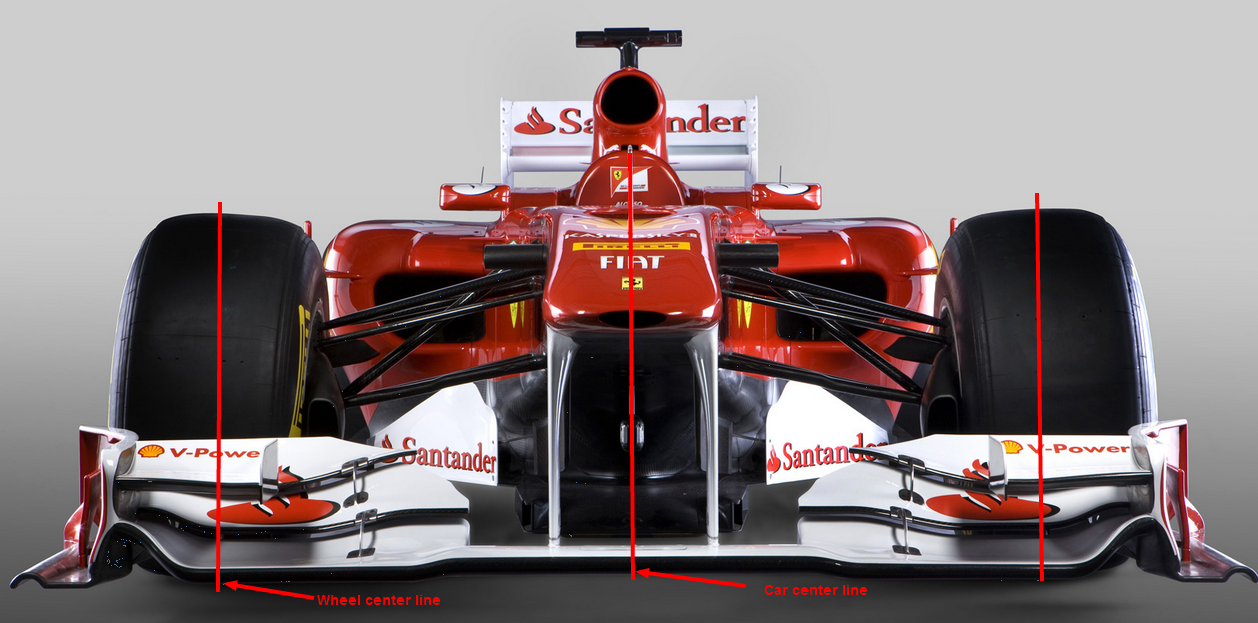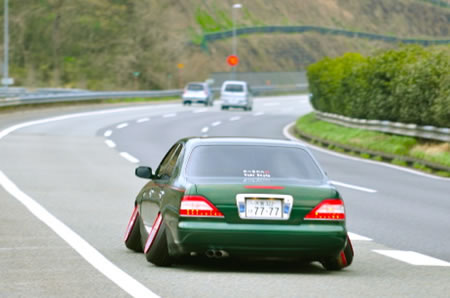Negative camber
#1

Posted 14 March 2014 - 06:40
Advertisement
#2

Posted 14 March 2014 - 09:41
"They" wouldn't be doing it to make friends!
#3

Posted 14 March 2014 - 09:52
I waited if perhaps posters that I know have an engineering degree reacted, but they are not there yet, so here I try to make sense (and if anyone wants to correct me, feel free)
A F1 car has little body roll, that is true, because you try to limit it with the front and rear-anti rollbar. But it does have SOME bodyroll. Anyway, it does not matter, because if the suspension of the car doesn't have to deal with the roll of weight from left to right, the TYRES have to it. So if a F1-car (or any car) has no roll, the tyres have to do all the hard work of the car leaning over on one side. And that IS the case with F1 cars, the tyres play probably the biggest role in dealing with the reaction forces we are dealing with.
Why the negative camber? Why not positive camber, for example with a pushrod-suspension? That I don't know. I do know that the suspension-arms 'rock' up and down along the tires and it depends on what phase in the corner you are in where the weight on the tyres is placed. If you release the brake and start turning in, out of the top of my head, the weight distribution is going to the inside front tyre and the rear-outside tyre. Those tyres are pressed to the ground in a different way than before, and will be loaded in a different way in the next phase (for example: exiting from the apex).
If you would use no camber, the temperature of the tyres would probably be on the outside of the tyre (I am not sure what would happen!). And that is bad, because a F1 tyre works best when the the carcas of the tyre is warmed up from the core to the outside, and that the temps are almost equal over the entire surface of the tyre. If I imagine a tyre being pressed to the ground, that has no negative camber, because of the forces working on it, probably the outside of the tyre would get the most load and the most temp...
I hope this is not too basic, nor to complex...
#4

Posted 14 March 2014 - 10:10
Im no chassis or tyre enginer but I think two reasons
As you say some negative will even out the tye temperatures across the tread as the tyre distorts sideways.
Negative camber generates side thrust big time- see any early Milliken studies. So as the car loads up the outside tyre ( regardles of roll) a large force is generated towards the inside of the corner.
So much negative gives horrible striaght line stability over bumps but that is of litle conecrn to an F1 car.
BTW the large difference in the diameter of the rear tyres on a US sprint car is aimed at doing the same thing - it gives instant, cheap negative camber on both rear wheels despite a solid axle. It has nothing to do with overcoming the lack of diff. action around corners as they are sideways anyway.
#5

Posted 14 March 2014 - 10:28
As it happens i was plotting out relaxation lengths today. And one of the results is that the relaxation length for camber is much less than for toe. I think it is sort of obvious why. So i wonder if running neg camber is a quicker version of toe in?
Bear in mind that although F1 cars have virtually no roll on the suspension, they still have roll on the tire stiffness.
#6

Posted 14 March 2014 - 11:08
Im no chassis or tyre enginer but I think two reasons
As you say some negative will even out the tye temperatures across the tread as the tyre distorts sideways.
Negative camber generates side thrust big time- see any early Milliken studies. So as the car loads up the outside tyre ( regardles of roll) a large force is generated towards the inside of the corner.
So much negative gives horrible striaght line stability over bumps but that is of litle conecrn to an F1 car.
BTW the large difference in the diameter of the rear tyres on a US sprint car is aimed at doing the same thing - it gives instant, cheap negative camber on both rear wheels despite a solid axle. It has nothing to do with overcoming the lack of diff. action around corners as they are sideways anyway.
Interesting. So that would mean that if you get to high tire temps on the inside of the tyre, you have too much grip by either wings or springload?
#7

Posted 14 March 2014 - 11:09
As it happens i was plotting out relaxation lengths today. And one of the results is that the relaxation length for camber is much less than for toe. I think it is sort of obvious why. So i wonder if running neg camber is a quicker version of toe in?
Bear in mind that although F1 cars have virtually no roll on the suspension, they still have roll on the tire stiffness.
Pardon my ignorance, but what is relaxion length?
#8

Posted 14 March 2014 - 15:31
I think the simplest answer is what Greg mentioned last. The tire is deformable, so in a corner those lateral forces tend to roll the tire. If you started off with zero camber, this roll would probably cause the inner edge to come off the ground. At the very least it would have less load than the outside edge. By starting with negative camber, it rolls so that the footprint is more evenly distributed, and probably has a lot more rubber on the ground.
If you want more complicated answers, yes there is a thing as camber thrust, and apparently it is more efficient at generating lateral force than slip angle (or toe). By more efficient, we mean less overall deformation and heat.
I have heard from people in-the-know that the simple answer (the evenly distributed footprint) is probably a stronger effect than the more complicated answer (camber thrust) for generating lateral force from F1 tires.
#9

Posted 14 March 2014 - 15:36
Regarding relaxation length, take a look at the Wikipedia page for it. It even mentions Greg's point about it being very small or zero for camber. It's not as immediately obvious to me why that is, though.
#10

Posted 14 March 2014 - 17:08
One question which none of this explains is why F1 so suddenly went to extreme negative camber. Long, long ago it was used then tyres were run more or less upright - now its quite extreme.
Last season ( I think) Pirelli got the FIA to limit the negative camber angle as it was so beneficialthat some teams ( Red Bull) were over stressing the tires with so much camber.
So what suddenly changed on an F1 car - or the tyre construction - to make negative camber so usefull?
#11

Posted 14 March 2014 - 18:33
The change to quasi-radials was one factor, the limits on rim widths, torque (I think) and the fact that F1 tyres don't have a rectangular X-section so the tyre doesn't distort as a parallogram.
#12

Posted 14 March 2014 - 22:05
As it happens i was plotting out relaxation lengths today. And one of the results is that the relaxation length for camber is much less than for toe. I think it is sort of obvious why. So i wonder if running neg camber is a quicker version of toe in?
Bear in mind that although F1 cars have virtually no roll on the suspension, they still have roll on the tire stiffness.
That is it Greg, the tyre rolling on the rim nescecitates the camber, both ends. Though they go too far often and may get a tenth somewhere but the tyre overheats on the inside and blisters or delaminates. As has happenened last year and on V8 Stupidcar for a couple of decades
#13

Posted 14 March 2014 - 23:04
That wiki article is good, but a bit dry. Basically, if you twist the wheel, whether in camber or toe, it takes a certain amount of time or distance for the belt and hence tread to aligh itself to the new angle and start generating force. It turns out that distance rolled is the important parameter for steering work. It is something we know about and measure but i have never tuned it (essentially it is a small time delay that occurs at both ends of the car so it gets lost in the noise) but it is controlled by tire pressure, section height and I would guess inertia of the belt.I have no doubt that Goodyear and Michelin model it correctly, and have theories. It'd be great if Ben or Tim chips in, I can't decide if it is a bit of a wank or something worth thinking about.
#14

Posted 15 March 2014 - 02:58
One question which none of this explains is why F1 so suddenly went to extreme negative camber. Long, long ago it was used then tyres were run more or less upright - now its quite extreme.
Last season ( I think) Pirelli got the FIA to limit the negative camber angle as it was so beneficialthat some teams ( Red Bull) were over stressing the tires with so much camber.
So what suddenly changed on an F1 car - or the tyre construction - to make negative camber so usefull?
I think Bloggsworth has most of your answer. Tire shape & construction has a lot to do with it - if you remember Bridgestone (rounded edges) vs. Michelin (square edges), teams used noticeably more negative camber with the former.
It's also possible there are wear and aerodynamic considerations.
#15

Posted 16 March 2014 - 05:04
I always thought that you set up a car for the track with negative camber in order to get the wheel to be as close to neutral (0 camber) when the car is cornering and the body roll caused the wheel to tilt towards positive camber. I can't picture in my mind how the tire moving on the rim has anything to do with that.
Also, why is there only such a great deal of negative camber on the front wheels?
Even mid corner it's obvious that the front wheels have a great amount of negative camber.
Are they trying to do something with camber thrust?
#16

Posted 16 March 2014 - 09:15
I'm very far from any kind of engineer. Just a curious bystander. But it looks like negative camber would help keep more of the outside-front tyre on the road when bashing over kerbs, yes? Though this is only a small portion of the driving, so I am sure they are doing it for other reasons also
#17

Posted 17 March 2014 - 18:25
I always thought that you set up a car for the track with negative camber in order to get the wheel to be as close to neutral (0 camber) when the car is cornering and the body roll caused the wheel to tilt towards positive camber. I can't picture in my mind how the tire moving on the rim has anything to do with that.
Look at the depiction of this tire which is undergoing roll (due to some lateral force at the contact patch). Now look at the accompanying contact pressure distribution. Surely the pressure would be more evenly distributed if the tire had been initially cambered, don't you think?

As for why they do it more on the front than the rear: part of it has to do with the tire widths, and some of it has to do with handling attributes like turn-in. But if you read the rest of this thread before commenting, you would notice my comment about how the inner front is the least loaded on an F1 car. The softer suspension on the rears is because they need both rear tires somewhat flat on the ground. A heavily cambered inside rear wouldn't do much good.
#18

Posted 17 March 2014 - 18:30
A couple addendums:
1) Yes, engineers would *also* compensate for body roll.
2) And nobody said the tire was "moving on the rim", which would be a serious problem. One might say it deforms relative to the rim.
#19

Posted 17 March 2014 - 21:35
Yes, even on a kart with no suspension to speak of if you aren't unweighting the inside front during cornering you need to push harder. The inside front hardly matters at speed, although this may be less true with DF.
Advertisement
#20

Posted 18 March 2014 - 19:34
Look at the depiction of this tire which is undergoing roll (due to some lateral force at the contact patch). Now look at the accompanying contact pressure distribution. Surely the pressure would be more evenly distributed if the tire had been initially cambered, don't you think?
As for why they do it more on the front than the rear: part of it has to do with the tire widths, and some of it has to do with handling attributes like turn-in. But if you read the rest of this thread before commenting, you would notice my comment about how the inner front is the least loaded on an F1 car. The softer suspension on the rears is because they need both rear tires somewhat flat on the ground. A heavily cambered inside rear wouldn't do much good.
This is exactly why its done on racecars.
The reason there is less on the rears is a mix of what you said about the need to keep the tyre flat on the ground for traction and the fact that the wider rear tyres do not pickup the contact patch so much on the inside.
#21

Posted 31 March 2014 - 09:35
Just as an aside too much neg reduces the braking, the poor tyre does not like trying to stop on half its width. Plus ofcourse you can overheat the inside of the tyre and it goes 'off' reducing braking again.
It will always be a trade off between turn, power down and braking. Power down for a long time and braking should be No1, but frequently becomes no 3. Pro racing is sometimes a committee meeting with the cornering person in dispute with the braking person.
This from a tyre rep re a well known Super car team that has been known to clutch defeat from the jaws of victory,,, to much camber and losing too many tyres
#22

Posted 01 April 2014 - 01:06
Apparently the primary function of negative camber is to look cool.
http://www.google.co...0.0.zH_nZ_slNFA
#23

Posted 02 April 2014 - 13:19
Rather illuminating, isn't it.
Very fast open-wheeler:

Very fast tin-top:

Slow road car. If you can't break the driving wheels loose in top gear, obviously the solution is not more horsepower, but more negative camber:


















